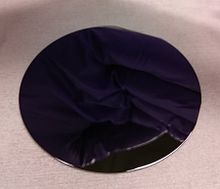
Back Galliumarsenied Afrikaans زرنيخيد الغاليوم Arabic Qallium arsenid Azerbaijani Арсенід галію Byelorussian Галиев арсенид Bulgarian Arsenur de gal·li Catalan Arsenid gallitý Czech Galliumarsenid Danish Galliumarsenid German Arseniuro de galio Spanish

| |
 GaAs wafer of (100) orientation
| |
| Names | |
|---|---|
| Preferred IUPAC name
Gallium arsenide | |
| Identifiers | |
3D model (JSmol)
|
|
| ChemSpider | |
| ECHA InfoCard | 100.013.741 |
| EC Number |
|
| MeSH | gallium+arsenide |
PubChem CID
|
|
| RTECS number |
|
| UNII | |
| UN number | 1557 |
CompTox Dashboard (EPA)
|
|
| |
| |
| Properties | |
| GaAs | |
| Molar mass | 144.645 g/mol[1] |
| Appearance | Gray crystals[1] |
| Odor | garlic-like when moistened |
| Density | 5.3176 g/cm3[1] |
| Melting point | 1,238 °C (2,260 °F; 1,511 K)[1] |
| insoluble | |
| Solubility | soluble in HCl insoluble in ethanol, methanol, acetone |
| Band gap | 1.424 eV (at 300 K)[2] |
| Electron mobility | 9000 cm2/(V·s) (at 300 K)[3] |
| -16.2×10−6 cgs[4] | |
| Thermal conductivity | 0.56 W/(cm·K) (at 300 K)[5] |
Refractive index (nD)
|
3.3[4] |
| Structure[5] | |
| Zinc blende | |
| T2d-F-43m | |
a = 565.315 pm
| |
| Tetrahedral | |
| Linear | |
| Hazards | |
| GHS labelling: | |

| |
| Danger | |
| H350, H360F, H372 | |
| P261, P273, P301+P310, P311, P501 | |
| NFPA 704 (fire diamond) | |
| Safety data sheet (SDS) | External MSDS |
| Related compounds | |
Other anions
|
Gallium nitride Gallium phosphide Gallium antimonide |
Except where otherwise noted, data are given for materials in their standard state (at 25 °C [77 °F], 100 kPa).
| |
Gallium arsenide (GaAs) is a III-V direct band gap semiconductor with a zinc blende crystal structure.
Gallium arsenide is used in the manufacture of devices such as microwave frequency integrated circuits, monolithic microwave integrated circuits, infrared light-emitting diodes, laser diodes, solar cells and optical windows.[6]
GaAs is often used as a substrate material for the epitaxial growth of other III-V semiconductors, including indium gallium arsenide, aluminum gallium arsenide and others.
- ^ a b c d Haynes, p. 4.64
- ^ Blakemore, J. S. "Semiconducting and other major properties of gallium arsenide", Journal of Applied Physics, (1982) vol 53 Nr 10 pages R123-R181
- ^ Haynes, p. 12.90
- ^ a b Haynes, p. 12.86
- ^ a b Haynes, p. 12.81
- ^ Moss, S. J.; Ledwith, A. (1987). The Chemistry of the Semiconductor Industry. Springer. ISBN 978-0-216-92005-7.
